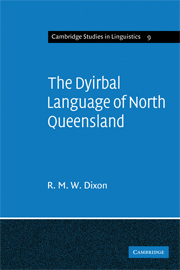Book contents
- Frontmatter
- Contents
- List of maps and plates
- Acknowledgements
- Preface
- Abbreviations and conventions
- 1 AUSTRALIAN LANGUAGES
- 2 DYIRBAL: THE LANGUAGE AND ITS SPEAKERS
- 3 WORD CLASSES
- 4 SYNTAX
- 5 DEEP SYNTAX
- 6 MORPHOLOGY
- 7 PHONOLOGY
- 8 SEMANTICS
- 9 LEXICON
- 10 PREHISTORY
- APPENDIX A DYIRBAL LOGIC
- APPENDIX B PREVIOUS WORK ON DYIRBAL
- TEXTS
- VOCABULARY
- LIST OF DYIRBAL AFFIXES
- REFERENCES
- INDEX OF AUSTRALIAN LANGUAGES
- Plate section
2 - DYIRBAL: THE LANGUAGE AND ITS SPEAKERS
Published online by Cambridge University Press: 05 November 2011
- Frontmatter
- Contents
- List of maps and plates
- Acknowledgements
- Preface
- Abbreviations and conventions
- 1 AUSTRALIAN LANGUAGES
- 2 DYIRBAL: THE LANGUAGE AND ITS SPEAKERS
- 3 WORD CLASSES
- 4 SYNTAX
- 5 DEEP SYNTAX
- 6 MORPHOLOGY
- 7 PHONOLOGY
- 8 SEMANTICS
- 9 LEXICON
- 10 PREHISTORY
- APPENDIX A DYIRBAL LOGIC
- APPENDIX B PREVIOUS WORK ON DYIRBAL
- TEXTS
- VOCABULARY
- LIST OF DYIRBAL AFFIXES
- REFERENCES
- INDEX OF AUSTRALIAN LANGUAGES
- Plate section
Summary
Linguistic type
Dyirbal is a typical Australian language. It is entirely suffixing, largely agglutinative, and has extraordinarily free word order.
Phonologically it is rather simple, having the smallest number of phonemes of any Australian language. In addition to four stop-nasal series – bilabial, apico-alveolar, dorso-velar and laminal – there is a single lateral, a semi-retroflex continuant, a trill and two semi-vowels. Dyirbal has the usual three-vowel system, length not being significant. Roots and inflected words begin with a consonant and have at least two syllables; intervocalically there are two and three-member consonant clusters. The first syllables of roots, and of most affixes, bear stress.
There are clearly defined classes of (first and second person) pronoun, noun, adjective, verb, adverbal, time qualifier, particle and interjection. There are four noun classes (genders), marked not in the form of a noun but by a ‘noun marker’ that normally accompanies a noun; noun markers also have some of the functions fulfilled by third person pronouns in other languages. A noun marker indicates the class of a noun, agrees with it in case, and also indicates whether the referent of the noun is visible or invisible; here or there; up hill, down hill, up river, down river or across river; and whether a long, short or medium distance up or down. Pronouns distinguish singular, dual and plural in both first and second person; there is no inclusive/exclusive distinction, and no incorporation of pronominal affixes into the verb.
- Type
- Chapter
- Information
- The Dyirbal Language of North Queensland , pp. 22 - 38Publisher: Cambridge University PressPrint publication year: 1972

